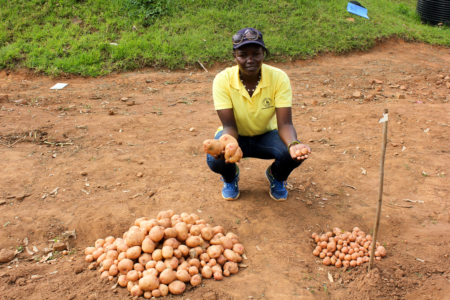
Late blight disease is a major constraint for potato production, costing farmers an estimated $3-$10 billion per year globally. In Uganda, where about 300,000 smallholder households grow potatoes for subsistence and income, the disease can destroy as much as 60% of a farmer’s potato crop, which translates into annual losses of approximately $129 million. Farmers commonly use fungicides to control late blight, but those agrochemicals are costly, the pathogen gradually adapts to them, and they pose potential risks to human health and the environment.
Potato breeders have spent years crossing cultivated potatoes with their wild relatives to produce late-blight-resistant varieties, but the resistance didn’t last and those varieties weren’t commercially successful. Farmers prefer growing varieties that consumers want, even if they require a significant investment in fungicides. Scientists at the International Potato Center (CIP) consequently decided to try genetic engineering to transfer genes that confer resistance to late blight in wild relatives of potato into potato varieties that are popular with farmers and consumers.
To do this, they collaborated with the Jiang Lab at the University of Wisconsin, which provided CIP with an RB gene that confers resistance late blight under a research license from the Wisconsin Alumni Research Foundation (WARF). CIP scientists then constructed a 3R-gene stack with two other genes that confer late blight resistance – Rpi-vnt1.1 and Rpi-blb2 – and used the bacteria Agrobacterium tumefaciens to transfer that 3R-gene stack into several potato varieties that are popular in East Africa.
Field trials undertaken in Uganda by the National Agricultural Research Organization (NARO) and CIP showed that those 3R transgenic potatoes have extreme and potentially durable resistance to late blight. CIP and NARO scientists subsequently decided to concentrate on one of them, a transgenic version of the variety Victoria, which is quite popular in East Africa but highly susceptible to late blight. They are currently undertaking multi-location field trials, and laboratory analyses to make a comprehensive risk assessment of that transgenic potato, in an effort to get it approved by Uganda’s National Biosafety Committee. In anticipation of an eventual release of transgenic, late-blight-resistant potatoes in Uganda, and perhaps other East African countries, CIP signed a Biomaterial License Agreement with WARF that allows the commercialization of potato varieties containing the RB gene in developing countries, following approval by national authorities.

“This 3R potato holds great promise for small-scale farmers,” said Marc Ghislain, who leads CIP’s Game-Changing Solutions program. He explained that Ugandan farmers commonly spend 10%—25% of the value of their potato harvests on fungicides, but because they usually wait until late blight begins to spread before applying those agrochemicals, they still suffer yield loss between 15% and 60%. He thus believes that a late-blight-resistant 3R potato variety could both reduce farmers’ production costs and increase their yields, which would have a major impact on the incomes and lives of smallholder families.
Ghislain explained that farmers who saw the results of the initial field tests at a NARO research station – where no fungicides were applied, and the 3R potato plants produced normal harvests while late blight destroyed the control plants – were very excited about the prospect of growing the 3R potatoes. Nevertheless, they will probably have to wait years for a late-blight-resistant variety to be approved for release in Uganda.
To achieve this goal, CIP and NARO are completing a rigorous assessment of the 3R potato to ensure that it poses no threat to human health or the environment. Researchers have recorded various parameters of plant development and tubers harvested at multi-locational field trials, and found no major visible differences between the conventional and transgenic potatoes, though statistics and laboratory analyses remain to be completed. Demonstrating that the 3R potato poses no risks to human health or the environment is a prerequisite for submitting a regulatory dossier for transgenic variety release, which CIP and NARO hope to submit to the National Biosafety Committee in 2019.
When and if Ugandan authorities approve the 3R variety, CIP and NARO plan to scale up its dissemination to farmers with careful stewardship and guidance. The new 3R variety is likely to be widely adopted by farmers, who should quickly recognize the benefits of a potato that can be grown without fungicide. In addition to lowering farmers’ production costs and improving their harvests, the late-blight-resistant potato will reduce the health and environmental risks that fungicides pose in potato-farming regions.
CIP and NARO are grateful to the support provided by the United States Agency of International Development (USAID) and the 2Blades Foundation but, as Ghislain noted, it needs more local sponsorship and involvement of Ugandan stakeholders in addition to NARO.
